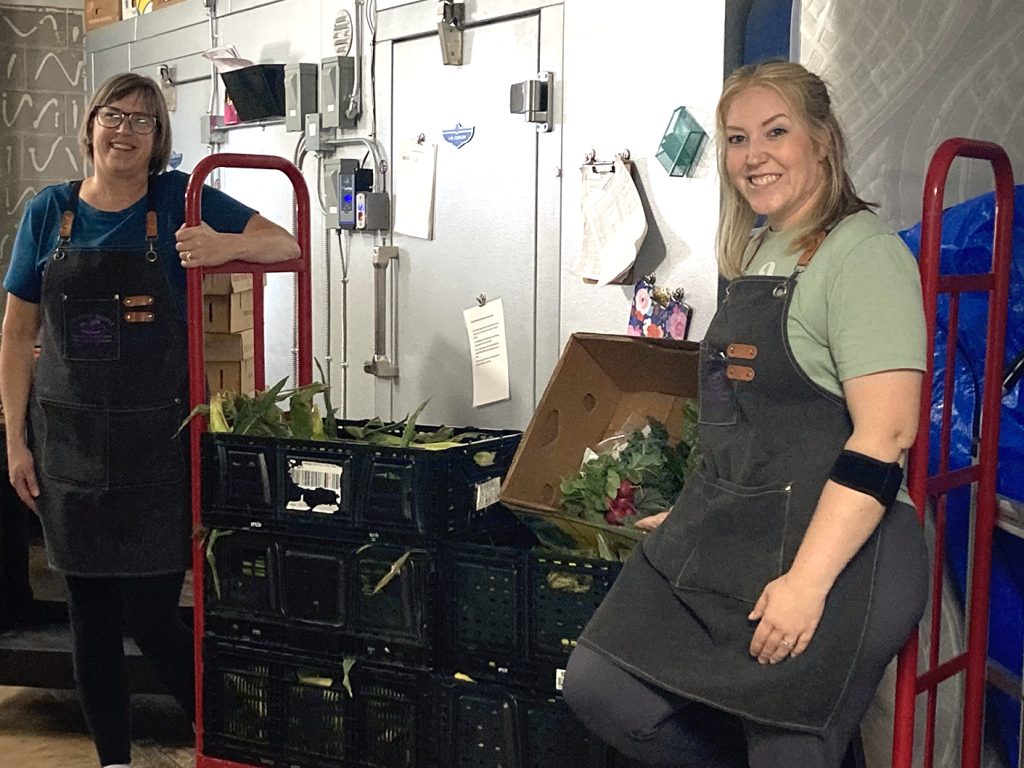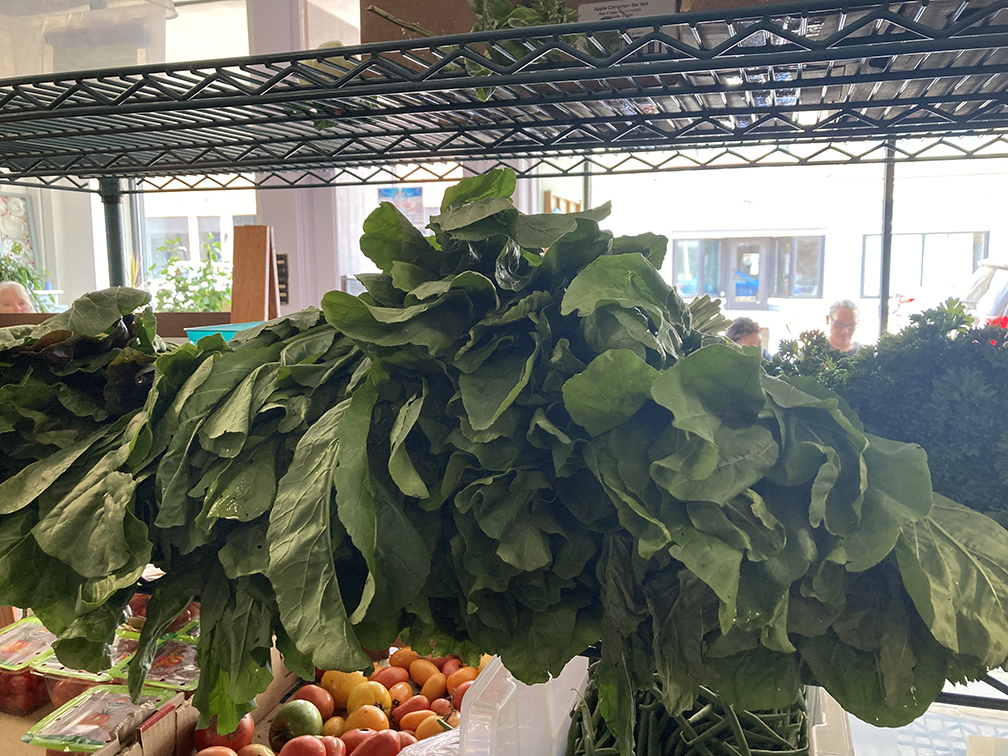Thanks to a new gleaning program, food pantry guests in Watertown are taking home locally grown, fresh produce on Tuesdays. Gleaning is collecting excess fresh foods from farms, gardens, grocers, or any other sources to provide it to those in need. Through a collaboration between the Watertown Farmers Market, the Bread Basket Food Pantry, and UW–Madison Extension’s FoodWIse program, more than 3,200 pounds of produce have been donated by farmers market vendors this year.

“We had no idea what would happen when we began this in June,” said Lisa Krolow, a FoodWIse Coordinator in Walworth and Jefferson Counties. The first week they gleaned 33 pounds of produce from market vendors. “We were over the moon. We thought we were so successful, because we didn’t know what we would get or if we would get anything.” After almost four months, the program is collecting an average of 250 pounds weekly.
For over 30 years, the Extension FoodWIse program has worked to improve access to affordable and healthy foods in communities throughout Wisconsin. FoodWIse is supported by the federal SNAP-Ed program, the funding for which was eliminated in the recent congressional reconciliation bill and takes effect Sept. 30, 2025. The Watertown project is an example of the type of work that FoodWIse educators will no longer be able to provide to communities all across Wisconsin.
Increasing local food security through gleaning
Access to healthy food is challenging in rural areas, and many Wisconsin families struggle to afford healthy food on a limited budget. At the same time, many edible and nutritious foods from farms and retail sites never make it to the table. Gleaning is one way to improve access to healthy foods while also reducing local food waste.
FoodWIse works with gleaning projects around the state to help connect SNAP-Ed eligible communities with gleaned fruits and vegetables. Often, gleaning projects come down to establishing partnerships and figuring out logistics. Krolow says that those pieces can be difficult to work through when you have an organization run completely by volunteers. That’s where she comes in.
Bringing experience and best practices to local organizations

“We know from years of experience and developing best practices within FoodWIse that gleaning projects are most successful when certain things are in place,” said Krolow. Using the experiences of her FoodWIse colleagues in other counties, she worked with local partners to make sure there was enough space to store donations and enough volunteers to transport and sort the items after the market. Now, as soon as the market ends for the day, volunteers take donations directly to the food pantry for that day’s guests.
With the logistics in place, Krolow has turned her focus to helping the market promote the gleaning project. Each week, there is a sign that shows market shoppers how the project is doing, and market vendors display a badge identifying them as a gleaning project participant. Krolow also works with the vendors to weigh their donations and the pantry provides receipts if the market vendor requests a record for tax purposes.
Providing locally grown, fresh food
Krolow began the project by bringing partners together. She thought the Bread Basket Food Pantry might be interested in providing more locally grown, fresh produce at their weekly food pick-ups so she approached them first. “They were completely on board. They said that they also had recognized the opportunity, they just didn’t know how to start it,” said Krolow.
The Bread Basket serves 47,000 people each year in Jefferson and Dodge Counties where 30% of the community lives paycheck to paycheck. Run entirely by volunteers, they have limited capacity to build new partnerships and start new programs. When Krolow approached them, they were excited to discuss options for a new gleaning program.
“We are not only providing fresh and nutritious produce to our guests, but also offering them a sense of hope and care. We’ve seen firsthand how our guests are adjusting their schedules to come in for the fresh fruits and vegetables, knowing that this abundance is there for them,” said Jess Thomm, a Bread Basket Volunteer assigned to the gleaning project. “It’s more than just food – it’s a reminder that they are seen, valued, and loved. This initiative not only improves their health but lifts their spirits, creating a ripple effect of positivity in our community.”
Krolow knew that produce vendors at the Watertown Farmers Market had produce leftover at the end of the market. “It’s still usable, but they may throw it out because they’re not having a market in the next few days and the produce will go bad, or they just don’t want to transport it back,” said Krolow. Working with the Watertown Farmers Market manager from the Main Street Program, Krolow got the go-ahead to set up the gleaning project and talk with vendors about their willingness to participate.
“I’m proud that our partnership with FoodWIse has brought 3,230 pounds of fresh produce to the Bread Basket,” said market manager Missy Kuckkan. “This generosity from our vendors is making a real difference for families in our community.”
Krolow estimates that 80% of produce vendors are participating in the gleaning program, often donating produce that they could easily sell the next day, but want to donate to the food pantry. Krolow remembers their biggest week so far when they gleaned 640 pounds of produce. “We broke a wagon. Literally. Broke a wagon. The pantry sent a wagon, they put stuff in it, and the wheel broke off,” said Krolow with a smile.
The enthusiasm is spreading to the larger community. Market shoppers often engage with food pantry volunteers to check on the running total of donations and buy extra produce to donate.
The role of gleaning in local food systems
As food prices increase, more families are turning to emergency food providers, like food pantries, to help put food on the table. Emergency food providers also face challenges in procuring food, particularly healthier options such as fresh and shelf-stable fruits and vegetables, whole grains, and dairy products.
As part of the SNAP-Ed grant, FoodWIse educators are trained and available to assess the need and feasibility of gleaning as a way to increase access to nutritious food. They also spend time developing partnerships with local organizations. Through those partnerships, they are able to connect gleaning opportunities with distribution sites.
Creating a successful gleaning program means that nutritious food is more available for SNAP-eligible residents. The next step is making sure they know what they produce is and how to prepare it safely. Krolow created educational materials that explain what the produce is, how to prepare it, and how to use it, including recipes. Having those handouts to go along with the gleaning program has encouraged pantry guests to try new foods, such as kale and kohlrabi.
For SNAP-eligible residents, the availability of produce has been very welcome. “They’re so happy to know that it’s fresh from the market. You hear people saying, ‘Oh yeah, it’s market day. What did you bring today? What do you have today?’” said Krolow. “They are so thankful to have the opportunity to have something from the market that they probably would not have been able to spend their own money on.”



